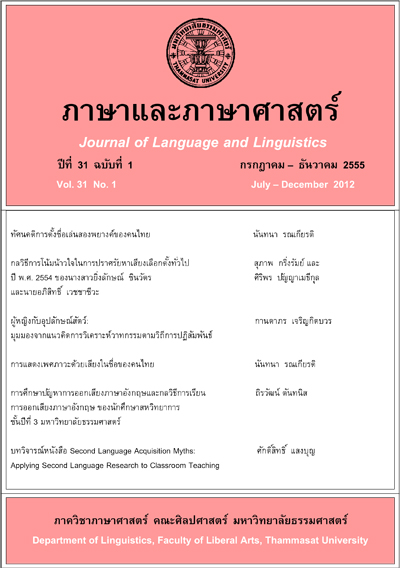การแสดงเพศภาวะด้วยเสียงในชื่อของคนไทย
Main Article Content
Abstract
บทคัดย่อ
งานวิจัยนี้มีวัตถุประสงค์เพื่อศึกษาหาลักษณะทางเสียงในแง่มุมทางสัทศาสตร์และสัทวิทยาที่ใช้เป็นเครื่องบ่งบอกเพศภาวะหญิงชายในชื่อของคนไทย ผลการศึกษาพบว่า ลักษณะชื่อของเพศหญิง มีแนวโน้มสัมพันธ์กับชื่อตั้งแต่ 3 พยางค์ขึ้นไป เช่น ฉัตรลดา พรรณพร ศุภิศรา และเป็นชื่อที่มีโครงสร้างพยางค์สุดท้ายเป็นพยางค์เปิด เช่น อภิศรา อภิญญา หรือ เป็นพยางค์ปิดแบบเสียงนาสิก เช่น ปนทอง ปริญญ์ ธนัญธร แต่หากพยางค์สุดท้ายของชื่อเป็นพยางค์ปิดแบบกัก มีแนวโน้มว่า โครงสร้างพยางค์อื่นๆ ก่อนหน้าพยางค์สุดท้ายจะเป็นพยางค์เปิด เช่น ชมพูนุท มโนรัตน์ เสาวลักษณ์ หรือ พยางค์อื่นๆ ก่อนหน้าพยางค์สุดท้ายเป็นพยางค์ปิดแบบเสียงนาสิก เช่น พิมพ์ลักษณ์ นันท์นภัสร์ สำหรับชื่อของเพศชายพบว่า มีแนวโน้มจะมีความสัมพันธ์กับการมีชื่อจำนวน 1-2 พยางค์ เช่น ตรอง ต่อฉัตร และมีโครงสร้างของพยางค์สุดท้ายเป็นพยางค์ปิด เช่น พิพัฒน์ ไตรสิทธิ์ หรือ เป็นพยางค์ปิดแบบกัก เช่น แทนภพ กรกฤต อัจฉริยะ แต่หากพยางค์สุดท้ายของชื่อเป็นพยางค์ปิดแบบกัก มีแนวโน้มว่าโครงสร้างพยางค์อื่นๆ ก่อนหน้าพยางค์สุดท้ายจะยังคงเป็นพยางค์ปิดหรือพยางค์ปิดแบบกัก เช่น สุกฤษฎิ์ ธนภัทร
Abstract
This research aims to investigate the phonetic and phonological features that reflect typical female and male identities found in the Thai naming practice. Results indicate that the female identity tends to be characterised by names with more than 3 syllables (e.g. /tþhatla?daù/, /phanna?phùn/, /su?phitsa?raù/), the final syllable structure of which often involves either a word-final open syllable (e.g. /?a?phitsa?raù/, /?a?phinyaù/) or a closed syllable with a nasal coda (e.g. /ponthùN/,/tha?nanthùn/). However, if the final syllable of the name is realised by a syllable-final plosive, a general trend is that the penultimate syllable will be either an open one (e.g. /tþhomphuùnut/, /ma?noùrat/) or one of the preceding syllables would be final nasal (e.g. /phimlak/,/nanna?phat/). In terms of the reflection of male identity, it found that most male names are formed by only 1 or 2 syllables (e.g. /trùN/, /tùtþhat/) with a likelihood that the final-syllable structure often incorporates a word-final closed syllable (e.g. /phi?phat/, /traisit/) or a syllable-final plosive (e.g. /thEùnphop/, /kùra?krit/, /?attþha?ri?ya?/). Having said that, in the case of the final syllable being a closed plosive one, a recurrent pattern would be that the structure of the penultimate syllable remains either a closed syllable or a final-syllable plosive (e.g. /su?krit/, /thana?phat/.
Article Details
บทความทุกบทความเป็นลิขสิทธิ์ของภาษาและภาษาศาสตร์


